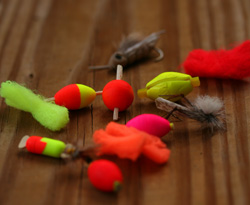The variety of strike indicators an angler can choose from can be dizzying, but many of them might not be the best choice for your nymphing situation. Yarn, foam footballs, putty, and dry flies can all be used as strike indicators. Each has its strengths and weaknesses. You’ll catch more trout on nymphs when you use the best strike indicator for the job. This article will discuss the strengths and weaknesses of each type of indicator.
Yarn
Yarn is our favorite strike indicator for several reasons. First of all it easy to use as much or little as you want to vary the size of the indicator. Yarn also sits up off the water which makes it easy to see. Since it is light it is also easy to cast and lights on the water without making any disturbance. There are some drawbacks to yarn strike indicators though. If you are fishing big, heavy nymphs or using additional split shots to fish flies deep in swift, turbulent water the yarn might not stay on the surface. It can get pulled under by currents in this type of fishing situation. Yarn should fish small nymphs #14 and smaller in this type of water and can even support a micro split shot.
We always put a little bit of fly floatant on our yarn before fishing it. Regardless of claims made on the packaging, we’ve found that a dab of floatant keeps the yarn floating longer and keeps it riding high on the surface where you can see it.
We attach the yarn by putting a slip knot in the leader. A slip knot allows an angler to either remove the yarn or move the placement of the yarn with relative ease. This can put a crimp in your leader when you remove the yarn. This doesn’t generally bother us when nymphing, but this is one thing that seems to irritate many anglers.
Pinch On / Stick On
Pinch on strike indicators are perhaps the easiest to use for novice anglers. They come on a sheet and a fly fisher simply has to wrap them around the leader and go fishing. Adhesive keeps it in place. While they are easy to use they have a number of drawbacks. The adhesive limits their ability to be adjusted. When you do move them or remove them from the leader the adhesive leaves some of the foam on the leader. These strike indicators work well for smaller nymphs in the range of #12 and smaller but don’t hold up larger nymphs or heavy rigs in turbulent water.
Foam Footballs
Styrofoam indicators in the shape of footballs or spheres are particularly effective in swift water with riffles and pockets. These come in a variety of sizes and it’s a good idea to keep several sizes on hand if you decide to use them. Larger, heavier flies require a bigger indicator and smaller nymphs cast better with a smaller indicator.
These types of strike indicators are usually quite easy to adjust for depth and don’t generally leave any impressions on your leader. They do have a tendency to hit the water with a plop, so they aren’t the best choice for fishing nymphs in quieter waters or places where fish might be exceptionally skittish.
We prefer to fish these indicators when the combination of weight on the fly and turbulent current will sink most other styles of strike indicator. For this reason we don’t usually fish the smaller sizes, but favor the medium to large sizes. Plenty of weight on the leader combined with a bulky strike indicator makes for tough casting. We recommend keeping casts short and either using a roll cast or short lob to get the flies in the water.
Putty
Putty strike indicators aren’t as common as they once were, but they can be useful in some circumstances. An angler can mold as much or little strike putty as he needs on his leader or tippet. However, putty indicators aren’t known for their ability to float very high and we’ve found a small amount of putty is best for small flies. Putty weighs more than the foam style or yarn indicators and will certainly come to the water with a plop if very much is used. However, a small amount on a leader can be fished discreetly and is a reasonable choice for anglers fishing small, light flies over midging trout or fish sipping emergers just under the surface.
Dry Flies
Perhaps the best type of strike indicator for midging fish or those sipping emergers is a dropper rig. A small, yet bushy dry fly like an Elk Hair Caddis or Royal Wulff will easily stay afloat over a midge pupa or soft hackle. Furthermore, many anglers are surprised at how often “selective” trout will eat an attractor pattern. Tie 12″ – 24″ of tippet to the bend of the hook of the dry fly. On eastern tailwaters a #18 – #22 midge pattern is good, but emerger patterns or unweighted nymphs are good choices depending on the hatch situation. Many accurate dry fly patterns like Comparaduns are effective dry flies that will also support a light nymph or emerger.
Larger bushier dry flies are better in tumbling freestone streams. Stimulators are an excellent choice and will support a host of beadhead patterns to fool fish in streams everywhere. The benefit of the dropper rig is that the dry fly is often just as effective as the nymph.
